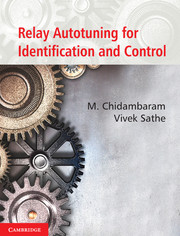Book contents
- Frontmatter
- Contents
- List of Figures
- List of Tables
- Acknowledgements
- Preface
- 1 Introduction
- 2 Improved Autotune Identification Methods
- 3 Cascade Controllers Tuning by Relay Autotune Method
- 4 Simultaneous Relay Autotuning of Cascade Controllers
- 5 A Simple Method of Tuning Cascade Controllers
- 6 Improved Saturation Relay Test for Systems with Large Dead Time
- 7 Identification of FOPTD Model using Single Symmetrical Relay Test
- 8 Autotuning of PID Controllers for Unstable FOPTD Systems
- 9 Autotuning of PID Controllers for Critically Damped SOPTD Systems
- 10 Estimation of SOPTD Transfer Function Model
- 11 Estimation of Five Parameters of Unstable SOPTD Model with a Zero
- 12 Identification of FOPTD Multivariable Systems
- 13 Identification of SOPTD Multivariable Systems
- 14 Tuning of Multivariable Controllers for Non-Minimum Phase Systems
- 15 Tuning of Multivariable Controllers by Genetic Algorithms
- 16 Summary and Conclusions
- Appendix A
- Appendix B
- Appendix C
- Nomenclature
- Problems
- Suggestive Reading
- References
- Index
4 - Simultaneous Relay Autotuning of Cascade Controllers
Published online by Cambridge University Press: 05 June 2014
- Frontmatter
- Contents
- List of Figures
- List of Tables
- Acknowledgements
- Preface
- 1 Introduction
- 2 Improved Autotune Identification Methods
- 3 Cascade Controllers Tuning by Relay Autotune Method
- 4 Simultaneous Relay Autotuning of Cascade Controllers
- 5 A Simple Method of Tuning Cascade Controllers
- 6 Improved Saturation Relay Test for Systems with Large Dead Time
- 7 Identification of FOPTD Model using Single Symmetrical Relay Test
- 8 Autotuning of PID Controllers for Unstable FOPTD Systems
- 9 Autotuning of PID Controllers for Critically Damped SOPTD Systems
- 10 Estimation of SOPTD Transfer Function Model
- 11 Estimation of Five Parameters of Unstable SOPTD Model with a Zero
- 12 Identification of FOPTD Multivariable Systems
- 13 Identification of SOPTD Multivariable Systems
- 14 Tuning of Multivariable Controllers for Non-Minimum Phase Systems
- 15 Tuning of Multivariable Controllers by Genetic Algorithms
- 16 Summary and Conclusions
- Appendix A
- Appendix B
- Appendix C
- Nomenclature
- Problems
- Suggestive Reading
- References
- Index
Summary
The present chapter is concerned with simultaneous relay autotuning of cascade controllers. Traditionally, autotuning procedures for cascade controllers are applied using a sequential, one-loop-at-a-time method. Saraf et al. (2003) proposed a simultaneous method of the relay tuning of series cascade control system. In this method, they assumed the principal harmonic analysis of relay oscillations. This results in error in calculation of the ultimate gains. The higher order harmonics are to be considered in the analysis of simultaneous relay tuning of series and parallel cascade control systems. Using improved ultimate gains, the inner loop (PI) and outer loop (PID) controllers are designed by the Ziegler–Nichols(Z-N) tuning method. The improved performance of the control is compared with the principal harmonic analysis reported by Saraf et al. (2003)
Introduction
Hang et al. (1994) proposed a sequential relay autotuning of series cascade control of stable systems. In this method, the outer loop is open. The on–off relay is used in the inner loop and the value of ku is obtained from 4h/(πa0). The controllers in the inner loop are tuned using the Ziegler–Nichols tuning formulae. With the inner loop under PI control action, the relay test is repeated for the outer loop.
Simultaneous relay tuning method is required whenever the system is to be kept under a closed loop in order to reduce the effect of disturbances or when the open loop system is unstable.
- Type
- Chapter
- Information
- Relay Autotuning for Identification and Control , pp. 43 - 56Publisher: Cambridge University PressPrint publication year: 2014

